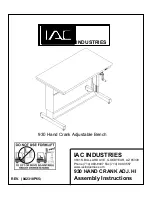
Page 10
LaCie RAID Technology White Paper
RAID 1
RAID 1
RAID 0
A2
A4
A6
A8
RAID 10
A2
A6
A8
A4
A1
A3
A7
A5
A1
A3
A5
A7
Disk 1
Disk 2
Disk 3
Disk 4
RAID 10
RAID 10 (also called RAID 1+0) is another RAID level that combines the attributes of other levels, specifically
RAID 1 and RAID 0. It is a “stripe of mirrored sets”, meaning that data is striped across two mirrored arrays.
The Striping occurs between arrays and the mirroring occurs within the same array, which makes the rebuilding
very fast. RAID 10 arrays should have disks in multiples of four. For LaCie products with five disks, in a RAID
10 array, the fifth disk will either be a spare or will be unused. See the diagram at right.
In a RAID 10 array, one disk from each mirrored pair can fail with no data loss. However, the working disk in
an array with a failed disk becomes a weak point for the entire array. If the second disk in a mirrored pair fails,
the entire array is lost.
Applications
RAID 10 provides good speeds because of
RAID 0 striping, but cuts the available capacity
of a device in half (assuming all disks in the
array have the same capacity).
LaCie Products with RAID 10
LaCie 4big quadra
✦
LaCie 5big network
✦
How RAID 10 Capacity Is Calculated
Each disk in a RAID 10 system should have the
same capacity.
Storage capacity in a RAID 10 configuration is
calculated by multiplying the number of drives
by the disk capacity and dividing by 2, or
C = n*d/2
where:
C = available capacity
n = number of disks
d = disk capacity
For example, in a RAID 10 array with four
drives each with a capacity of 1000GB, the
total capacity of the array would be 2000GB:
C = (4*1000)/2
RAID 0
RAID 1
RAID 3
RAID 3+Spare
RAID 5
RAID 5+Spare
RAID 6
RAID 0+1
RAID 10
Concatenation
JBOD
RAID Selection
































